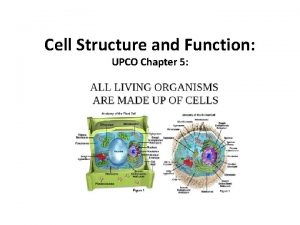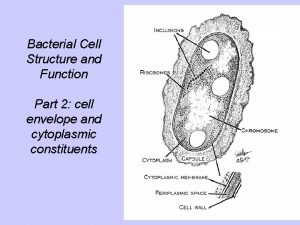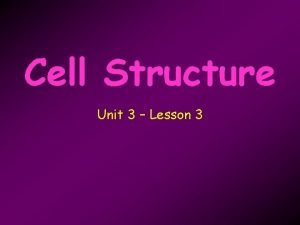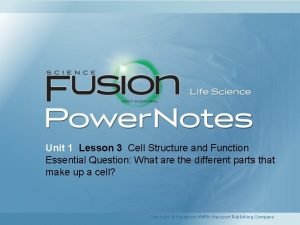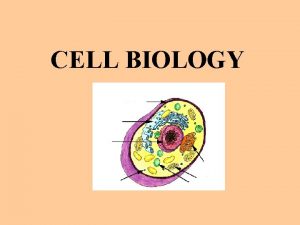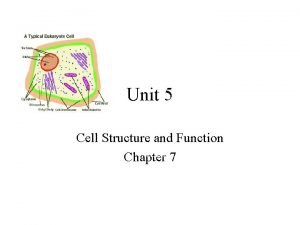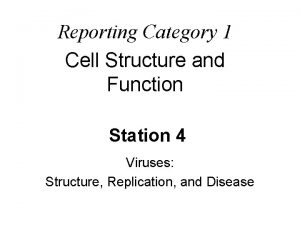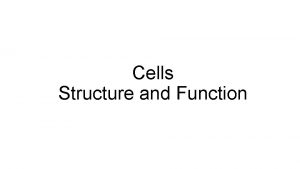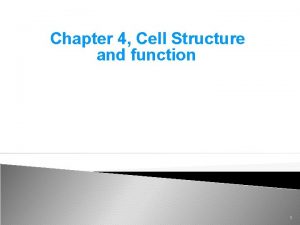Cell Structure and Function Text Reading Chapter 4


























- Slides: 26

Cell Structure and Function Text Reading : Chapter 4 Lecture Outline 1. 2. 3. 4. Cell Membrane : Structure and Properties Nucleus Cytoskeleton Organelles 44

The cell is the smallest living unit to perform all vital physiological functions Cells can grow, reproduce, obtain nutrition, and interact with their environment. Cell components are built with proteins, carbohydrates, lipids and nucleic acids. Eggs (ova) and sperm are classified as “sex cells”; all other cells in the body are considered “somatic cells”. Every cell has an outer boundary called the cell membrane or plasma membrane Cells contain organelles and intracellular fluid Cells are surrounded by extracellular fluid, which is the interstitial fluid of the tissue extracellular fluid = interstitial fluid 45

Human Cells are Diverse in Shape and Function https: //facinatingamazinganimals. files. wordpress. com/2012/04/cell-types. gif 46

The Cell Membrane The cell membrane is a phospholipid bilayer with proteins, lipids and carbohydrates Functions: • Physical isolation – separates cell from environment • Selective regulation of exchange with the environment • Maintains chemical gradients between inside and outside • Communication with environment outside cell 47

Phospholipid molecules give the cell membrane its structure Bilayer: Two sheets of phospholipid molecules arranged with fatty acid “tails” facing each other Cholesterol molecules stabilize the membrane 48

Phospholipid molecules give the cell membrane its structure 1. HYDROPHOBIC INTERIOR vs. HYDROPHILIC EXTERIOR 2. MEMBRANE FLUIDITY : The phospholipid molecules of the bilayer are NOT bound together; this allows the molecules to move around in the membrane and allows new lipids to move in and out of the membrane. Hydrophobic interior of bilayer Phosphatecontaining head provides hydrophilic inner and outer membrane surface 49

A schematic view of the cell membrane if it contained only the phospholipid bilayer Any substance trying to pass through this membrane would need to pass through the hydrophobic region containing the lipid tails 50

Membrane Proteins give the cell its unique function Membrane Proteins are classified by relationship to lipid bilayer: Integral Proteins (embedded in membrane) Peripheral Proteins (bound to inner or outer surface) 51

All proteins are amino acid chains that have bent, twisted and/or folded into unique shapes With protein lengths up to 100, 000 amino acids, the variety of shapes is unlimited; transmembrane protein chains always have nonpolar regions associated with the hydrophobic fatty acid portion of the membrane, and polar or charged areas facing the intra- or extracellular fluid hg. med. umich. edu Protein forming membrane pore 52

Membrane Proteins give the cell its unique function Membrane Proteins are also classified by function 53

Carbohydrates are also associated with the plasma membrane and form the Glycocalyx Different classes of membrane carbohydrates depending on what they are bound to proteoglycans, glycolipids, glycoproteins Extend away from cell surface – Lubrication – Anchor cell to extracellular material – Bind extracellular molecules – Recognized by immune system cells in their search foreign invaders 54

The Fluid-Mosaic membrane model Membrane Video The cell membrane is not a fixed entity Lipids move around with respect to their neighbors, add in and out of the membrane Proteins move around, are added and removed as needed to alter cell function 55

“Plasma membrane” vs. “membrane” The plasma membrane (the outer boundary of the cell) is only one membrane associated with the cell. Numerous structures within the cell, including the nucleus and several organelles, also have a 56 membrane component.

The nucleus is the center of cellular operations Surrounded by a nuclear envelope “double membrane” = two phospholipid bilayers Nuclear pores allow communication with cytoplasm 57

Contents of the nucleus Nucleoplasm DNA and related proteins – Chromosomes are the form of DNA when it is tightly packed with histone proteins into structures visible at the time of cell division – Chromatin is the uncoiled, loose form of DNA present the rest of the time, when a cell is in the active, non-dividing state One or more nucleoli – active areas within DNA, dark cluster or “spot”; indicative of active protein synthesis 58

DNA: chromosomes vs. chromatin Same stuff, different arrangement 59

The interior of the cell contains: • Nucleus • Intracellular Fluid (cytosol) • Organelles CYTOPLASM Nonmembranous organelles not enclosed by a membrane (Include cytoskeleton, centrioles, ribosomes) Membranous organelles are surrounded by phospholipid membranes (Include endoplasmic reticulum, Golgi apparatus, lysosomes, mitochondria) 60

The Cytoskeleton : the structural support network within the cell Microfilaments: Smallest; weblike arrangement inside the plasma membrane (actin); help in cell movement and support Intermediate filaments: Strong, resist mechanical stress to cell, stabilize the position of organelles within cytoplasm Microtubules: Largest; long and hollow; provide strength and rigidity to cell; anchored in centrosome; chromosome movement 61

The cytoskeleton is more extensive than you might think 62

Centrioles are intimately involved with the cytoskeleton • The 2 centrioles organize the cytoskeleton • Cytoplasm surrounding the centrioles is the centrosome • Microtubule structure, anchors with microtubules of cytoskeleton • Direct the movement of chromosomes during cell division 63

Three organelles involved in protein synthesis Ribosome, endoplasmic reticulum, Golgi apparatus Ribosome: Site of protein synthesis Composed of a large and a small subunit, each containing ribosomal RNA (r. RNA) and proteins Can be “free” or “fixed” in cytoplasm Endoplasmic Reticulum: Intracellular membranes involved in synthesis, storage, transportation and detoxification Forms cisternae – spaces inside separate from cytoplasm Rough ER (r. ER) contains bound ribosomes during protein synthesis Smooth ER (s. ER) - involved in lipid synthesis Golgi apparatus: Modify, package and ship new proteins to their destination inside or outside the cell 64

Relationship of r. ER to Golgi Apparatus and Membrane New proteins move from the r. ER through the Golgi Apparatus to final destinations within the cell 65

Mitochondria : the cell’s powerhouse Responsible for ATP production through aerobic respiration Matrix = fluid contents of mitochondria Cristae = folds in inner membrane, large surface area for enzyme activity Food and oxygen in, ATP and carbon dioxide out 66

Adenosine Triphosphate (ATP) is a critical organic molecule ATP is a high energy compound which stores cellular energy in high energy bonds Made by adding a terminal phosphate group to adenosine diphosphate (ADP) in the mitochondria Removal of terminal phosphate group converts ATP to ADP, releasing energy ; this reaction drives most cellular activity 67

Lysosomes Membrane bound vesicles filled with digestive enzymes Responsible for breakdown of ingested substances 68

69
 Making connections images
Making connections images While reading activities
While reading activities Eukaryotic cell structure
Eukaryotic cell structure Chapter 7 cell structure and function section review 7-2
Chapter 7 cell structure and function section review 7-2 Chapter 5 cell structure and function
Chapter 5 cell structure and function Middle lamella
Middle lamella Chapter 4 cell theory and cell study
Chapter 4 cell theory and cell study Bacterial cell structure and function
Bacterial cell structure and function Lesson 3 cell structure and function answer key
Lesson 3 cell structure and function answer key Cell structure graphic organizer
Cell structure graphic organizer Plant and animal cell diagram
Plant and animal cell diagram Lesson 3 cell structure and function answer key
Lesson 3 cell structure and function answer key Organelle graphic organizer
Organelle graphic organizer Cell structure and function
Cell structure and function Unit 5 cell structure and function answer key
Unit 5 cell structure and function answer key Category 1 cell structure and function
Category 1 cell structure and function Category 1 cell structure and function
Category 1 cell structure and function Stages of mitosis in onion root tip
Stages of mitosis in onion root tip A report text
A report text What text features are included in this text
What text features are included in this text Chapter 2 reading informational text answer key
Chapter 2 reading informational text answer key Denuding tower
Denuding tower Prokaryotic reproduction
Prokaryotic reproduction Animal rights vs animal welfare venn diagram
Animal rights vs animal welfare venn diagram Tonoplast
Tonoplast Primary voltaic cell
Primary voltaic cell Difference between plant and animal cell
Difference between plant and animal cell




